英语第一课
- 格式:doc
- 大小:22.50 KB
- 文档页数:1

英语第一课课文Unit 1 My name's Gina. Section A 1a - 2d.一、单词短语。
1. 单词。
- name /neɪm/ n. 名字;名称。
- nice /naɪs/ adj. 令人愉快的;宜人的。
- to /tuː; tə/ 常用于原形动词之前,表示该动词为不定式。
- meet /miːt/ v. 遇见;相逢。
- too /tuː/ adv. 也;又;太。
- your /jɔː(r)/ pron. 你的;你们的。
- his /hɪz/ pron. 他的。
- her /hɜː(r)/ pron. 她的。
2. 短语。
- my name我的名字。
- nice to meet you很高兴见到你。
二、课文内容(1a - 2d)1. 1a.- 这部分主要是一些关于名字的单词,如Alice, Bob, Cindy, Dale等,通过这些名字引出关于询问名字和自我介绍的话题。
2. 1b.- 听力练习,听对话然后将名字与对应的人物匹配。
对话示例:- A: What's your name?- B: My name's Gina.- 这个对话简单地展示了如何询问名字和回答名字。
3. 1c.- 结对练习,仿照1b中的对话,用1a中的名字进行问答练习。
例如:- A: What's your name?- B: My name's Bob.4. 2a - 2b.- 2a是听力练习,听对话然后将名字与相应的描述匹配。
2b则是根据2a的听力内容填写名字。
对话中包含了更多关于名字和人物关系的表达,如:- A: Is he Jack?- B: No, he isn't. His name's Mike.5. 2c.- 这是一个角色扮演活动。
学生根据2a - 2b中的对话内容,进行角色扮演,练习询问名字和确认身份的表达。
6. 2d.- 对话示例:- Linda: Good afternoon! My name's Linda. Are you Helen?- Helen: Yes, I am. Nice to meet you, Linda.- Linda: Nice to meet you, too. What's your last name, Helen?- Helen: Miller. What's your last name?- Linda: Brown.- 在这个对话中,我们可以学习到下午的问候语(Good afternoon),自我介绍(My name's...),询问对方是否是某人(Are you...?),回答是的(Yes, I am.),以及询问姓氏(What's your last name?)等表达。
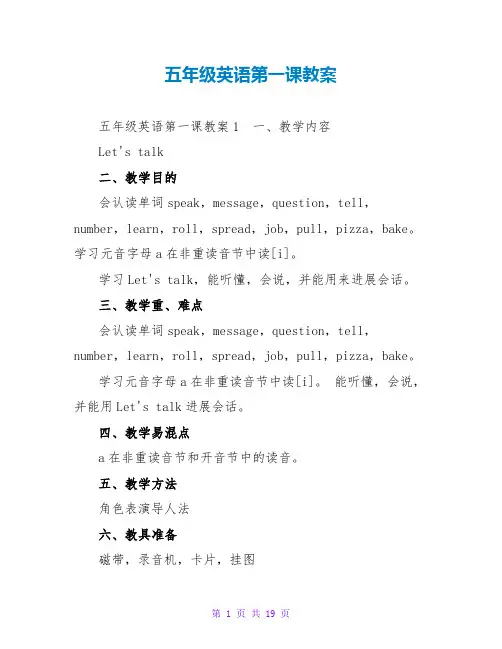
五年级英语第一课教案五年级英语第一课教案1 一、教学内容Let's talk二、教学目的会认读单词speak,message,question,tell,number,learn,roll,spread,job,pull,pizza,bake。
学习元音字母a在非重读音节中读[i]。
学习Let's talk,能听懂,会说,并能用来进展会话。
三、教学重、难点会认读单词speak,message,question,tell,number,learn,roll,spread,job,pull,pizza,bake。
学习元音字母a在非重读音节中读[i]。
能听懂,会说,并能用Let's talk进展会话。
四、教学易混点a在非重读音节和开音节中的读音。
五、教学方法角色表演导人法六、教具准备磁带,录音机,卡片,挂图七、教学过程【学习单词】学习speak,message,question,tell,number,learn,roll,spread,job,pull,pizza,bake等单词。
【导人新课】学习单词拼读规那么: 对本课个别单词的读音进展简单分析^p 并从中总结规律,通过分析^p 单词speak并联络eat,meat,tea,please,read等单词复习"ea母组合读[i:]";通过分析^p spread并联络head,bread,ready,dead,breakfast等单词复习"ea字母组合读[e]";通过分析^p 单词question学习tion读[t∫?n],如suggestion;通过分析^p tell,job复习元音字母e和o 在重读闭音节的读音,通过分析^p message并联络village,orange等单词学习元音字母a在非重读音节中读[i];通过分析^p 单词bake复习元音字母a在重读开音节中的读音。
B.导人对话:本课可用角色表演法导人。
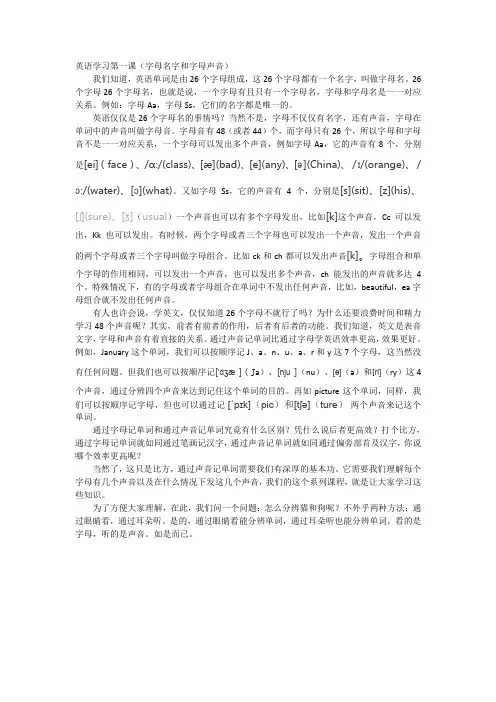
英语学习第一课(字母名字和字母声音)我们知道,英语单词是由26个字母组成,这26个字母都有一个名字,叫做字母名。
26个字母26个字母名,也就是说,一个字母有且只有一个字母名,字母和字母名是一一对应关系。
例如:字母Aa,字母Ss,它们的名字都是唯一的。
英语仅仅是26个字母名的事情吗?当然不是,字母不仅仅有名字,还有声音,字母在单词中的声音叫做字母音。
字母音有48(或者44)个,而字母只有26个,所以字母和字母音不是一一对应关系,一个字母可以发出多个声音,例如字母Aa,它的声音有8个,分别是[ei](face)、/ɑ:/(class)、[æ](bad)、[e](any)、[ə](China)、 /ɪ/(orange)、 /ɔ:/(water)、[ɔ](what)。
又如字母Ss,它的声音有4个,分别是[s](sit)、[z](his)、[ʃ](sure)、[ʒ](usual)一个声音也可以有多个字母发出,比如[k]这个声音,Cc可以发出,Kk也可以发出。
有时候,两个字母或者三个字母也可以发出一个声音,发出一个声音的两个字母或者三个字母叫做字母组合。
比如ck和ch都可以发出声音[k]。
字母组合和单个字母的作用相同,可以发出一个声音,也可以发出多个声音,ch能发出的声音就多达4个。
特殊情况下,有的字母或者字母组合在单词中不发出任何声音,比如,beautiful,ea字母组合就不发出任何声音。
有人也许会说,学英文,仅仅知道26个字母不就行了吗?为什么还要浪费时间和精力学习48个声音呢?其实,前者有前者的作用,后者有后者的功能。
我们知道,英文是表音文字,字母和声音有着直接的关系。
通过声音记单词比通过字母学英语效率更高,效果更好。
例如,January这个单词,我们可以按顺序记J、a、n、u、a、r和y这7个字母,这当然没有任何问题。
但我们也可以按顺序记['dʒæ](J a)、[nju](nu)、[ə](a)和[ri](ry)这4个声音,通过分辨四个声音来达到记住这个单词的目的。
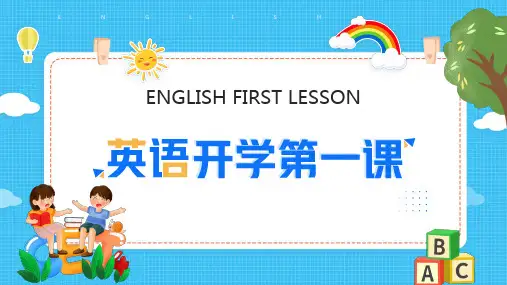
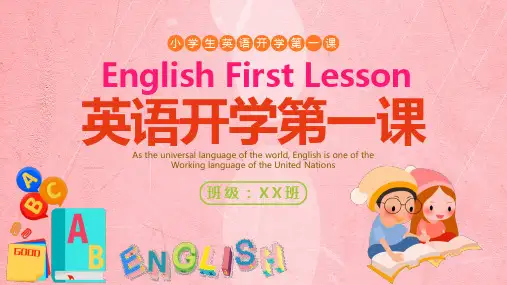

八年级l上册英语第一课知识点八年级上册英语第一课知识点八年级上册英语第一课的名字叫做 Welcome back to school,是一节介绍如何欢迎新学期的课程。
下面我们来总结一下这节课的知识点。
1. 问好和介绍自己遇见新同学和老师,需要问好并介绍自己。
可以用像“Hello, my name is…”或者“Nice to meet you.”这样的句型。
2. 谈论课程表在新学期,课程表通常有所变化,需要谈论课程表,并列出上课时间和地点。
可以用像“What classes do you have today?”或者“Do you have English in the afternoon?”这样的问句。
3. 谈论活动学校通常会在新学期组织各种各样的活动,需要谈论这些活动,并决定哪些活动值得参加,或者自己想参加的活动。
可以用像“Have you heard about the school dance?”或者“I want to do some volunteering this semester.”这样的句型。
4. 谈论成绩新学期开始,老师通常会公布上学期的成绩,需要谈论自己的成绩并决定如何提高自己的成绩。
可以用像“Have you seen your grade yet?”或者“Do you have any tips on studying for tests?”这样的问句。
5. 谈论目标新学期开始,有时候会设立一些学习目标,需要谈论自己的目标,并确定如何完成这些目标。
可以用像“My goal is to improvemy English speaking skills.”或者“Do you have any suggestions for achie ving my goal?”这样的句型。
以上就是八年级上册英语第一课的知识点。
希望大家在新的学期里能够取得更好的成绩!。
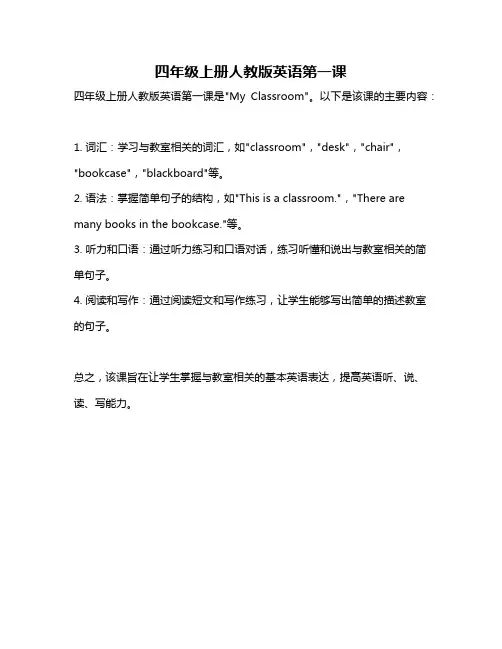
四年级上册人教版英语第一课
四年级上册人教版英语第一课是"My Classroom"。
以下是该课的主要内容:
1. 词汇:学习与教室相关的词汇,如"classroom","desk","chair","bookcase","blackboard"等。
2. 语法:掌握简单句子的结构,如"This is a classroom.","There are many books in the bookcase."等。
3. 听力和口语:通过听力练习和口语对话,练习听懂和说出与教室相关的简单句子。
4. 阅读和写作:通过阅读短文和写作练习,让学生能够写出简单的描述教室的句子。
总之,该课旨在让学生掌握与教室相关的基本英语表达,提高英语听、说、读、写能力。
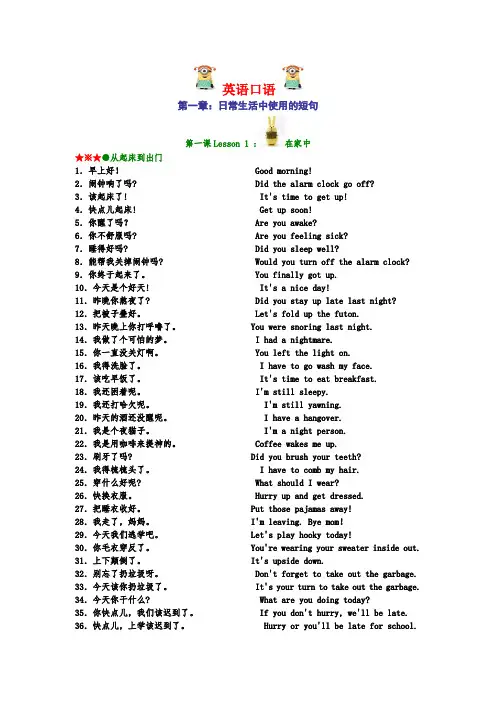
英语口语第一章:日常生活中使用的短句第一课Lesson 1 :在家中★※★●从起床到出门1.早上好! Good morning!2.闹钟响了吗? Did the alarm clock go off?3.该起床了! It's time to get up!4.快点儿起床! Get up soon!5.你醒了吗? Are you awake?6.你不舒服吗? Are you feeling sick?7.睡得好吗? Did you sleep well?8.能帮我关掉闹钟吗? Would you turn off the alarm clock? 9.你终于起来了。
You finally got up.10.今天是个好天! It's a nice day!11.昨晚你熬夜了? Did you stay up late last night? 12.把被子叠好。
Let's fold up the futon.13.昨天晚上你打呼噜了。
You were snoring last night.14.我做了个可怕的梦。
I had a nightmare.15.你一直没关灯啊。
You left the light on.16.我得洗脸了。
I have to go wash my face.17.该吃早饭了。
It's time to eat breakfast.18.我还困着呢。
I'm still sleepy.19.我还打哈欠呢。
I'm still yawning.20.昨天的酒还没醒呢。
I have a hangover.21.我是个夜猫子。
I'm a night person.22.我是用咖啡来提神的。
Coffee wakes me up.23.刷牙了吗? Did you brush your teeth?24.我得梳梳头了。
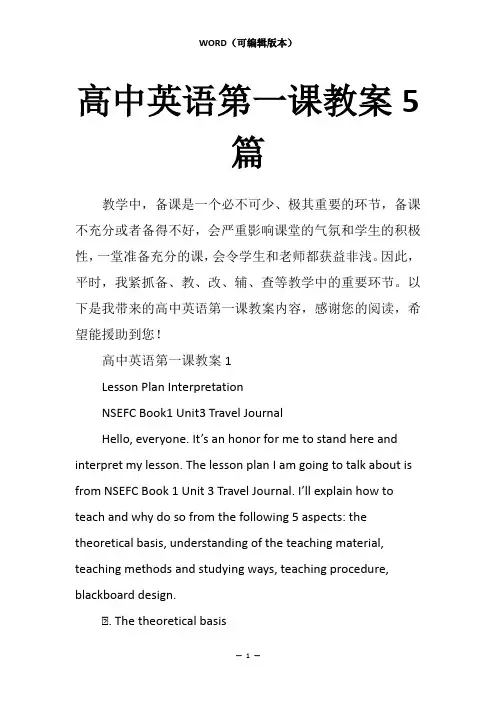
高中英语第一课教案5篇教学中,备课是一个必不可少、极其重要的环节,备课不充分或者备得不好,会严重影响课堂的气氛和学生的积极性,一堂准备充分的课,会令学生和老师都获益非浅。
因此,平时,我紧抓备、教、改、辅、查等教学中的重要环节。
以下是我带来的高中英语第一课教案内容,感谢您的阅读,希望能援助到您!高中英语第一课教案1Lesson Plan InterpretationNSEFC Book1 Unit3 Travel JournalHello, everyone. It’s an honor for me to stand here and interpret my lesson. The lesson plan I am going to talk about is from NSEFC Book 1 Unit 3 Travel Journal. I’ll explain how to teach and why do so from the following 5 aspects: the theoretical basis, understanding of the teaching material, teaching methods and studying ways, teaching procedure, blackboard design.Ⅰ. The theoretical basisFirst, I’d like to show my theoretical basis--schema theory and top-down model (Goodman, 1971). Journey down the Mekong is a reading course. According to schema theory, reading prehension is an interactive process between the reader’s background knowledge and the text (Carrel and Eisterhold, 1983), or between the new information and the old knowledge store (Anderson and Pearson, 1984). So in order to improve the students’ reading speed and reading prehension, language teachers should try to activate the Ss’ old knowledge store and add more relevant background knowledge before they get the students to read. According to the top-down model, general idea of the text will be got first, and then e the details.II. Understanding of the teaching materialMy understanding of the teaching material includes 3 parts: the status and the function, teaching objectives, the important and difficult points.At the beginning, let’s focus on the first part. Journey down the Mekong is a piece of travel journal written by Wang Kun. It’s mainly about Wang Kun and his sister’s dream of taking a great bike trip down the Mekong River, their preparation for the trip and some more details of the Mekong River. General speaking, it is not difficult for the students to understand thetext, but there are some new phrases and sentences that may be a little bit difficult. So before the students’ first reading, I will explain the new words and phrases briefly and after reading the whole passage, I will embody the usage of the news words and phrases, and get the student understand the difficult sentences. As it is a piece of journal, besides learning the new words and phrases, students can get the general idea of how to write a journal.That’s all for the first part, now let’s move to the second part. According to the teaching material and the new curriculum of English, in order to fulfill the learning task of this lesson, I establish the following objectives:a) Knowledge objectivesBy the end of the lesson, Ss will have a better understanding of the meaning and structure of the text. Then Ss will grasp some useful words and expressions such as determined, make up one’s mind, give in, be fond of …, care about…, stubborn, etc.b) Ability objectivesActually students should be encouraged to do speed reading in the first period of reading lesson. But the students in my class are lack of independent reading ability. In this class, Iwill encourage and help them to read, think and find out information by themselves most time. Since the main objective of reading course is to improve the Ss’ reading ability, I’ll train their ability of identifying the general idea in the fast reading. And in intensive reading their ability of information-gathering and summarizing is developed. And the whole class is for Ss to develop their reading skills as scanning, skimming, information-gathering, summarizing and guessing the new words from the text.c) Moral objectivesThough Journey down the Mekong is mainly about the trip down the river, it also talks about the scenery and life along the river. So before learning the text, we will have a short discussion about the importance of the river. I want the Ss to have the awareness of protecting the river and protecting our environment.Well, so much for the teaching objectives, lets e to deal with the third part: the important points and the difficult points. According to the national curriculum of English and language learning theory, when teaching reading, we should encourage the Ss to do speed reading for the first time, that’s to say, we should encourage our Ss to read as fast as they can when theydo the first reading. So much emphasis should be put on reading skills and reading prehension as well. So the important points are that how to make Ss grasp the new words and phrases and how to improve their reading skills as scanning, skimming, information-gathering and summarizing. As to the difficult points, they are the same as the important ones.III. Teaching methods and studying waysThat’s all for my understanding of the teaching material. Now let’s focus on the ways of teaching and learning.Generally speaking, I adopt task-based language teaching and municative approach in my class. As for learning, Ss will learn through independent reading, discussing and cooperating.I will use puter and blackboard as my teaching aids.Ⅰ. Teaching procedureHere es the most important part, the teaching procedure. It includes 5 steps: Step I: Lead-in andpre-reading, Step II: While-reading, Step III: Consolidation, Step IV: Post-reading, Step V: Homework.Step I: Lead-in and pre-reading (7mins)Now let’s e to the first step. There are three activities in this step and I will spend 7mins on them.In activity one, I will ask Ss two questions Do you know some great rivers in China? and Why they are great?” Here, asthe Ss get familiar with the Chinese great rivers, I choose to ask them some great rivers in China. And the answer to the second question can lead in the next activity--brainstorming.In activity two, I will ask the Ss to discuss in pairs and answer the question How do people who live along a river use it?” My purpose of this activity is to remind the Ss the importance of the river, thus stimulate the Ss awareness of protecting the rivers.In the last activity, I will show the Ss a picture of the Mekong River and ask them to list the countries that it flows through. This activity leads in the while-reading.Step II: While-reading (21mins)While-reading is the main part and it will take 21mins. Here I adopt the top-down reading model. This step is divided into 2 parts: fast reading and careful reading. Before reading, I will ask the Ss to predict what will talk in the text according to the title. It can exert the Ss imagination.1) Fast readingDuring fast reading, I will ask the Ss to reading the whole passage quickly and get the main idea of each paragraph. Usually, the main idea of each paragraph is the first sentence or the last sentence, but this text is not. So the main idea of eachparagraph will be matched because the Ss are lack of the skill of summarizing the main idea by themselves.2) Careful readingAfter getting the general idea of each Para., I will deal with the details Para. by Para..In paragraph one, I will ask the Ss to read quickly and do the exercises T or F. And if it is F, I will ask them to correct it. This exercise can help the Ss get the key information of the first paragraph in a short time and can deepen the Ss’ understanding of the first paragraph.In paragraph two, I will ask Ss one question “Is it a difficult journey to cycle along the Mekong? Why?” This can help the Ss develop their ability of summarizing. If the Ss can’t answer the question briefly, I will encourage them to find the key sentences and try to join them together.And in the last paragraph, I will ask Ss two questions “How does the water of Mekong River change?” and “What can you see when you travel along the Mekong River?” Both questions are required to answer in keys word. In order to lower the difficulty of the questions, I will show them the examples. After that, I will present some pictures to deepen the Ss’ impression on the new words. And these two questions can help the Ssgain a deeper understanding on the Mekong River.Step III: Consolidation (6mins)After dealing with the detailed information of each paragraph, I will ask the Ss to read the whole passage again and answer two questions to consolidate what they’ve learnt. It will take 6 minutes. The two questions are “Where is the source of the Mekong River and which sea does it enter?” and “How do Wang Kun and Wang Wei prepare for the trip?” It is easy for the Ss to find the answer to the first question in the text. As to the second question, it may be a little difficult, so I will list some tips for the Ss to find the answer more easily.Step IV: Post-reading (10mins)That’s all for the while-reading. Now let’s move to the fourth step. In this step, I will design two activities and I will spend 10 minutes on them.The first activity is filling in the blanks. In this activity, Ss are required to find the different attitudes of Wang Kun and Wang Wei to the trip, and then the teacher will express her attitude to this trip. After demonstrating, Ss are encouraged to express their attitudes. It can help the Ss train their ability of information-gathering and expression.The second activity is thinking. In this activity, I will ask theSs to discuss in groups of four and try to use some words to describe the characteristics of Wang Kun and Wang Wei according to their attitudes. It is really difficult, but it can not only train their ability of analysis and prehension, but also cultivate their spirit of cooperationStep V: Homework (1min)Finally it es to the homework. Ss are required to review the learnt lesson and underline the useful words and phrases in the text. This one is for them to consolidate what they’ve learnt and make preparation for the next lesson—Learning about the Language..Ⅰ. Blackboard designOn the top, there is the title of this lesson. On the left, it lists some important roles that the river plays. On the right, there are some useful words and expressions.That’s all for my interpretation. Thank you for your att高中英语第一课教案2一. 教材内容分析本单元的中心话题是“电影”,本课是第三课时,是一篇传记体的短文,介绍当前好莱坞最有影响的导演艺术家—史蒂芬斯皮尔伯格的创作生涯和一些作品。
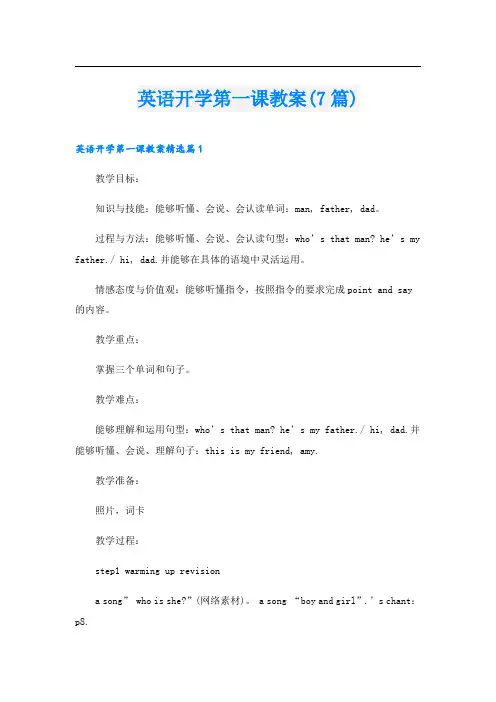
英语开学第一课教案(7篇)英语开学第一课教案精选篇1教学目标:知识与技能:能够听懂、会说、会认读单词:man, father, dad。
过程与方法:能够听懂、会说、会认读句型:who’s that man? he’s my father./ hi, dad.并能够在具体的语境中灵活运用。
情感态度与价值观:能够听懂指令,按照指令的要求完成point and say的内容。
教学重点:掌握三个单词和句子。
教学难点:能够理解和运用句型:who’s that man? he’s my father./ hi, dad.并能够听懂、会说、理解句子:this is my friend, amy.教学准备:照片,词卡教学过程:step1 warming up revisiona song” who is she?”(网络素材)。
a song “boy and girl”.’s chant:p8.my friends.引导学生介绍自己的朋友。
如:hi, i’m ’m from chin is my friend, ’s a ’s a ’s from china/ the uk/ canada/ the usa/ australia. step2 presentation practice1.以旧带新,学习新知(let’s talk)(1)教师:呈现mr jones,问:who’s he?引导学生答:he’s mr jones.教师:mr jones is a man.(2)学习单词man,并扩展woman对比进行学习。
2.词融于句,巩固新知活动1:呈现男教师的照片,让学生练说: mr… is a man.活动2:呈现男明星的照片,让学生练说:如yao ming is a man. and learn(1)呈现教师自己爸爸的照片:look, that is a ’s that man? can you gu?教师出示答案:he’s my father.(2)学习father,并扩展mother对比学习。
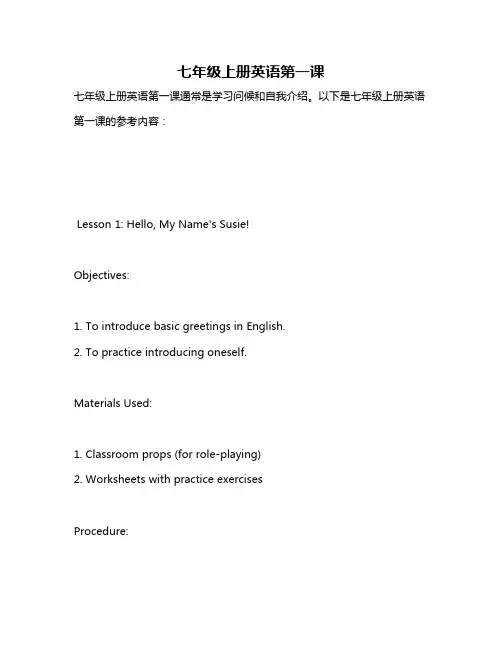
七年级上册英语第一课七年级上册英语第一课通常是学习问候和自我介绍。
以下是七年级上册英语第一课的参考内容:Lesson 1: Hello, My Name's Susie!Objectives:1. To introduce basic greetings in English.2. To practice introducing oneself.Materials Used:1. Classroom props (for role-playing)2. Worksheets with practice exercisesProcedure:1. Greeting the Class: The teacher greets the class in English, "Hello, everyone! Today we're going to learn how to introduce ourselves in English."2. Introducing the Topic: The teacher writes the topic "Introduction" on the board and defines it for the students. They will learn how to introduce themselves in English and practice with each other.3. Teaching the Content:The teacher teaches the students the basic greetings in English, such as "Hello," "Hi," "Good morning," etc. They also learn how to reply to these greetings.The teacher writes these greetings on the board and practices them with the class. The students repeat after the teacher and try to imitate the pronunciation.4. Practice Activities:The students practice introducing themselves in pairs. They use the phrases they have learned and act out role-plays together.The teacher distributes worksheets with practice exercises. The students complete these independently or in groups.5. Assessment: The teacher observes the students as they practice and provides feedback on their pronunciation, grammar, and fluency.The teacher also checks their worksheets to see if they understand the new vocabulary and structures.6. Closure: At the end of the lesson, the teacher reviews the main points covered and reinforces the importance of introducing oneself in English. They encourage the students to practice at home with family members or friends. The bell rings, signaling the end of class.此课通过实践活动和互动练习,让学生能够轻松地掌握自我介绍的基本知识和技能,提高他们的英语口语交际能力。
【导语】新的⼀学期⼜开始了,你的开学第⼀课教案准备好了吗?以下是为⼤家精⼼整理的内容,欢迎⼤家阅读。
【篇⼀】英语开学第⼀课教案:⾼⼀ ⼀、⾃我介绍(Introduce myself 3′) Hello everybody, Well,nice talking with you here. I'm your English teacher, next year we will learn together, with the progress. I have worked for 1 years since I graduated from the university . Being a teacher is tired but excited . Having taught for this year, I think I am experienced in teaching field . I have a strong sense of duty and humor.Actually , I always think that English is so wonderful a language that we should not only regard it as a subject,but also look on it with great interest.Hope you can enjoy your way in English.I will be happy to be your company. ⼆、学习⽅法介绍( 20′) * 学习英语⽆捷径, 。
要想学好英语只有⼤量实践,多听多读多说多写。
不要被商业⼴告所误导。
* 对于⾼中英语学习者我特别推荐英语简易读物,读的材料要浅易,故事性要强,读的速度尽可能快⼀些,读的越多越好。
这是学好英语屡试不爽的⼀个好办法。
* 说英语⼀不要怕犯错误,⼆不要怕别⼈笑话。
Unit1 The king’s new clothes一、重点词组:1. the king’s new clothes国王的新衣服2.long long ago很久以前3. one day 一天4. two men 两个男人5. visit the king 拜访国王6. make new clothes for you= make you new clothes 给/替你做新衣服make sb sth=make sth for sb替/给某人做某物7. Show the king his new clothes= Show his new clothes to the king给国王看他的新衣服Show sb sth= show sth to sb(give , pass) 给某人看某物8. try on these magic clothes试穿神奇的衣服try it / them on 试穿它/它们(代词必须放中间)9. clever people 聪明的人10. foolish people 愚蠢的人11. walk through the city in his new clothes 穿着新衣穿过城市12. a lot of people =lots of / many people 许多人13. in the street 在街上14. look at the king看着国王15. What beautiful clothes!/What a beautiful coat!/What an interesting story!感叹句构成:What +a/ an +形容词+单数名词!What +形容词+复数名词或不可数名词!16. a little boy 一个小男孩17. point at the king 指着国王18. wear some clothes 穿着衣服19. want to do sth 想要做某事20. laugh at sb 嘲笑某人21. fit well 很合身22. this afternoon / morning / evening 今天下午/早晨/傍晚23. get a card from my good friend得到朋友送的卡片24. come to my party 来参加我的聚会25. at half past four=at four thirty 在四点半26. an American cowboy 一个美国牛仔27. wear jeans / a kilt 穿着牛仔裤/一条英格兰短裙28. a Scottish man 一个英格兰男人29. play a game 玩游戏30. tell (sb) a story 给(某人)讲故事31 each student 每一个学生32. say one / the first / the next sentence 说一/第一/第二/下一句话33. on the mountain 在山上34. an old man 一位老人35. It’s one’s turn to do sth. 轮到某人做某事。
小学英语第一课教案小学英语第一课教案小学英语第一课教案1 第一课时一、教学目的1. 能听、说、读、写词汇:gifts, flowers, card, birthday party, balloons, candles.2. 能在实际生活中灵敏应用以上词汇3. 引导学生完成Part C Look and write 局部二、教学重点能听、说、读、写词汇:gifts, flowers, card, birthday party, balloons, candles. 能在实际生活中灵敏应用以上词汇三、教学难点引导学生完成Part C Look and write 局部四、教学环节学习目的〔2分钟〕〔一〕出示学习目的:学习“四会”单词:gifts, flowers, card, Birthday party, balloons, candles.〔二〕学生齐读学习目的内容,明确本节课任务。
自主学习〔15分钟〕〔一〕温故知新师生问答 T: What are you going to do after class? S: I’m going to ...His birthday is on ..., and my birthday is on ... T: What about your birthday?〔二〕阅读方法对照课本边看边练习拼写本课单词。
1.利用卡片认识单词。
2.逐个学习单词,学生练习读单词,老师纠音。
〔三〕互助释疑同桌间一边指着图片,一边读出单词,交流不会读的单词。
〔四〕探究出招同桌间练习书写,可以互相检查拼写。
讨论每个单词的复数形式。
展示交流〔10分钟〕小组展示小组内练惯用英语说说可以看见的东西,加深单词的记忆。
点拨升华〔8分钟〕〔一〕老师放录音,学生跟读,纠正读音。
〔二〕学生开火车读单词。
课堂作业〔5分钟〕作业当堂清 Part C Look and writeWhat does Miss White have for her birthday?She has a big ____ cake, six___, twenty-seven____, three____, and some _____ .小学英语第一课教案2 一、教学目的:1、通过师生之间的交流,营造一个温馨舒适的师生气氛。
七年级英语书上册第一课科普版翻译Unit 1 Lesson 1: Scientific Blueprints科普版第一课: 科学蓝图In this lesson, we will explore the world of science and learn about scientific blueprints. We will understand how science works and how it helps us understand the world around us.在这节课上,我们将探索科学的世界,了解科学蓝图。
我们将理解科学是如何工作的,以及它如何帮助我们理解周围的世界。
Science is about observing, questioning, and finding answers. It involves making observations or gathering data, developing hypotheses, conducting experiments or investigations, and drawing conclusions based on evidence.科学是关于观察、质疑和寻找答案的过程。
它涉及到观察或收集数据、提出假设、进行实验或调查,并根据证据得出结论。
Scientific blueprints are plans or models that scientists develop to understand natural phenomena or solve problems. They help scientists organize their thoughts and guide their investigations.科学蓝图是科学家为了理解自然现象或解决问题而制定的计划或模型。
它们帮助科学家组织思维并指导他们的研究。
人教版七年级上册英语第一课讲解
以下是有关人教版七年级上册英语第一课的讲解:
首先,本课将学习问候和介绍他人的基本表达。
学生将了解如何使用英语进行简单的自我介绍和询问他人的基本信息,例如姓名、年龄和职业等。
本课的核心知识点包括:
1. 问候语:如“Hello”、“Hi”和“Good morning”等。
2. 介绍他人的句型:如“This is my friend, John”和“She is a doctor”等。
3. 询问和回答关于个人信息的句型:如“What’s your name?”、“How old are you?”和“What’s your job?”等。
本课的教学重点和难点包括:
1. 正确使用问候语和介绍他人的句型,避免混淆或遗漏重要信息。
2. 在询问和回答个人信息时,能够灵活运用不同的疑问词和代词。
通过本课的学习,学生将能够用英语进行基本的自我介绍和询问他人,提高他们的口语交际能力。
同时,他们将了解英语中常见的问候和介绍他人的表达方式,为后续的学习打下坚实的基础。
第一课
俗话说“万事开头难”。
在上第一堂英语课之前,大部分小学生对英语“白纸一张”,一无所知。
因此,老师如果上好了这第一堂课,将极大地影响着学生今后的英语学习。
常言说得好“良好的开端是成功的一半”,那么如何做好这“良好的开端”呢?通过对小学生学习心理的研究和本人十几年来的教学经验所得,我摸索出了一个上好小学英语第一堂课的教学模式,如下:
一课前准备
小学生学习欲强、活泼好动,对一切新鲜的事物都非常的感兴趣。
但由于自出生之日起,学生已习惯听到中国话,看到中国字,突然让他们学习一个陌生的语言,他们会用一个什么样的态度来对待这个学习呢?这就要看老师如何在第一堂课上对学生怎么引导了。
在这当中,英语教师的形象又显得非常重要。
为了让学生对英语教师有一个独特而鲜明的印象,上第一堂英语课之前,老师一定要精心打扮一番。
男教师可以带上领带,西装革履,走起路来要有“绅士风度”,有时甚至可以准备一个英式的“文明棍”,俨然一副老外的派头。
这样,当你一走上讲台学生便会一下子给吸引住了。
“亲其师而善其道。
”学生对你这个教师感兴趣了,就会对你所教的这门学科感兴趣。
除了穿着之外,教师还要准备英语课常用的录音机,磁带挂图,卡片等教具,让学生感受到英语课特有的“气味”。
二开场白
千万不要因为你的学生听不懂英语就来个中文的开场白,你要从一开始就让你的学生习惯于听英语,如果学生不懂,你可以尽量通过体态语,动作,表情等让学生理解你的话,但尽量不说中文,就仿佛你是一名外籍教师来中国上课时一样,让学生对英语产生更浓厚的兴趣。
要学会“卖关子”,越是让人不明白的事就越能吊起人的口味。
一走上讲台,你就说:“Hello! Boys and girls!”“Class begins.”等来组织教学,然后自我介绍,“(I’m Mr…(或I’m Miss…)”学生听不懂没关系,用手势,表情,再通过反复演练让他们理解。
如果课后有学生问你:“你上课讲的那都是些什么呀?我们一句也听不懂。
”你可以告诉他,“那就是你们要学习的‘英语’!”这说明你已经激发起他们的兴趣了。
三学习英语的重要性的介绍
光有学习英语的兴趣还不行,在一开始,你就要让学生明白他们为什么要学习英语,以引导学生学习英语的动机。
只有让学生动机明确了,他们的兴趣才会持久。
通常老师在上第一堂英语课的时候,就应向学生介绍这样一些知识:1、英语的发源地和应用地区;2、国际通用语言比较;3、我国改革开放政策与学习英语的必要性;4、英美文化发展与成就。
当然,在介绍学习英语的重要性时,也不要忘了肯定中国的文化成就,加强爱国主义教育,向学生指出,正是由于热爱自己的祖国,为了把自己的祖国建设好,我们才要学好英语,以吸取别人的经验来建设自己的国家。
四必要的学习纪律和课堂纪律的强调
纪律是学习的保障。
学习英语并不是一件轻松的事,因此,除了兴趣和动机以外,我们还要培养学生的坚忍不拔的学习意志。
英语老师要在一开始就订立几条学习纪律,比如,每天什么时候读英语、什么时候背单词等等,使学生的学习不致成为“一头热”行动。
此外,在适当的时候也可以告诉学生学习英语是个漫长而又艰苦的活动,需要顽强的意志来支配自己的学习,在以后的学习中,一定要“胜不骄败不馁”等等。
由于小学生自制力较差,因此良好的学习习惯和纪律是增强学生意志的必要手段。
从一开始就注意学生意志的培养,有利于学生学习英语活动的持久性和高效性。
五英语文化的幽默性与唯理性的介绍
英语的文化魅力,突出表现在其幽默性和唯理性上,在上第一堂英语课时就要让学生在教师身上感受到这种独特的文化魅力。
你要给学生一个印像,你是一个即和蔼可亲又乐观睿智的师长。
当第一堂课下课铃响时你可以跟学生说:“I’m sorry, I must go now. They are jealous of our happy-ness.”“Bye-bye.”等。
要让学生从一开始就享受到上英语课的欢乐。
总之,在上第一堂课之时教师就要让学生建立起对英语课的初步印象,激发起对英语学习的兴趣、引导学生正确的学习动机、培养他们不畏艰难的学习意志,以保证他们日后的英语学习一路顺风。